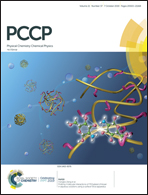Chiral metallic glass nanolattices with combined lower density and improved auxeticity
Abstract
Auxetic materials are promising structural and functional candidates due to their unique lateral expansion when stretched, however, bulk metallic glasses (MGs) could not show any auxeticity because of their intrinsic isotropic nature. Here we construct chiral Cu50Zr50 metallic glass nanolattices with cavities, and investigate their auxeticity and underlying mechanism with molecular dynamics simulations. It is found that, compared to monolithic MGs, all the chiral metallic glass nanolattices (CMGNs) exhibit improved auxeticity and lower density. For CMGNs with cavities, the negative Poisson's ratio and ultimate tensile strength (UTS) increase first and then decrease with increasing cavity radius, with the cavity radius of 2.5 nm being the most favorable for auxeticity and enhanced UTS. The auxetic mechanism is attributed to the competition between rotation behavior and non-affine deformation under tension. Our study not only reveals the mechanism of auxeticity in CMGNs having cavities but also provides a feasible method to optimize their auxetic performance and density by structure designing of MGs.



 Please wait while we load your content...
Please wait while we load your content...